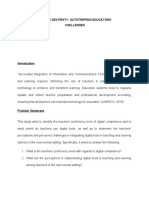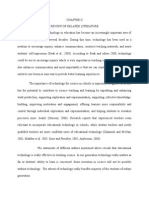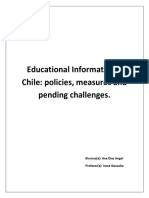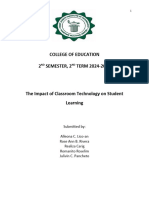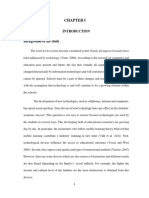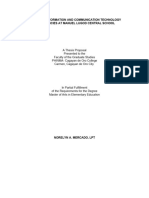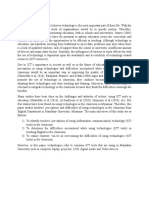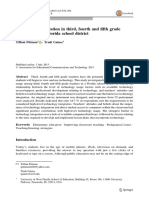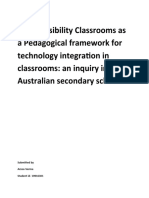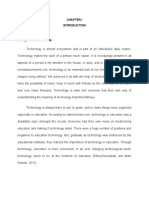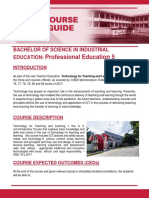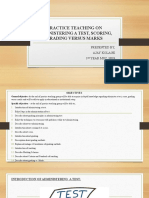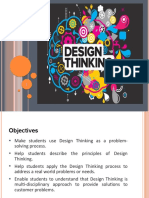Chapter I
INTRODUCTION
This chapter presents the background of the problem, the statement of the problem, the significance of the study, and the
scope and delimitation of this study.
Background of the Problem
Technology continues to advance across various fields and is one of the necessities for our world to keep up with the
demands of modern development. One of the entities that promotes technology is educational institutions, which emphasize its use.
In a classroom setup, technology is more visible and more effectively utilized, serving as a valuable tool in a student's activities.
Additionally, according to Huma et al., 2022, the teachers positively perceived integrating technology in teaching and learning
practices. Using technology makes the learning process more exciting and interactive as it keeps the learners motivated to study. In
the classroom, a student begins to nurture their abilities and minds.
Correspondingly, technology development enhances collaboration between students and teachers, making it more efficient in
helping learners become more academically competitive and versatile in the classroom. Now that we are still in a post-pandemic era
where hybrid learning is implemented, technology can also support remote learning. However, challenges such as hardware failures,
software incompatibilities between home and school, lack of internet access, and outdated programs are still faced by both teachers
and students. Additionally, academic dishonesty may occur due to the technological development of graphical calculators, high-tech
gadgets, and small cameras. Technological advancements also contribute significantly to distractions in modern life, and excessive use
of technology might negatively impact students' health ( Mdhlalose & Mlambo, 2023).
The study of Akram et al. (2022) suggests that concerned authorities should set clear and effective policies to make efficient
use of ICT by allocating a sufficient budget and ensuring all necessary facilitation (e.g., ICT infrastructure, tools, software, internet,
and labs) in all educational institutions. It is also important to train teachers to apply ICT in their teaching practices successfully.
Despite these recommendations, the study by Mastul et al. (2023) also has the same findings as Akram's study, which is the lack of
infrastructure, teacher training, funding, digital divide, resistance to change, and technical difficulties are the barriers to effective
implementation of technology in classrooms. In a recent study conducted by Windfont (2024), it was also suggested that more
comprehensive professional development and support are necessary for teachers to effectively integrate technology, especially for
special education students. Mastul et al (2023) also suggested that the administration should take the lead in promoting educational
technology in their classrooms.
Moreover, technology integration in the classroom is seen as an important educational innovation to enhance teaching and
learning processes in the 21st century. Teacher motivation has been seen as a critical prerequisite for successful technology integration
�in the classroom, particularly in the early phases of educational innovation (Backfisch et al., June 2021). Additionally, according to the
findings of the study of Nguyễn (2022), the majority of the learners agreed that using technological tools such as films and YouTube in
learning environments helps them improve their communication skills such as speaking and listening skills. However, Martin's (2022)
study suggests that technology may negatively impact students' communication skills, highlighting the need for research on how
technology influences this aspect of development and what practices could mitigate any adverse effects.
Technology's influence on education is a complex phenomenon that has advantages and disadvantages in the classroom.
Carstens et al. (2021) conducted a study titled 'Effects of Technology on Student Learning,' which explores this complex relationship
and provides insights into educators' perceptions and uses of technology. The study's conclusions, which were based on opinions
provided by educators via an extensive survey, highlight the general trend of emphasizing the advantages of technology over its
drawbacks. In terms of benefits, the study shows how well technology may be used to improve the educational experiences of
students. Teachers acknowledge and value the beneficial contributions that technology brings to the education landscape, as seen by
the survey. These could include more engaging activities, a variety of teaching strategies, and the creation of lively, interactive
learning spaces. However, the research highlights the necessity for a diverse viewpoint. With a positive attitude toward technology,
the results imply that to promote greater independence, children might need more instruction with the given technological
instruments. This insightful statement emphasizes how crucial it is to embrace technology for all of its intrinsic advantages while also
realizing how crucial education and training are to achieving its potential.
An alternative approach to discovering new teaching methods and learning outcomes with technology is by applying the
PICRAT model. Created at Brigham Young University in 2020, this model streamlines other technology evaluation frameworks. It is
designed as a tool for reflection, not as a strict guideline, to help us consider how technology is incorporated into our classrooms.
(Kimmons, R., Graham, C. R., & West, R. E. 2020)
The PICRAT model is a three-by-three matrix with 'PIC' on one axis and 'RAT' on the other. The RAT axis focuses on the impact of
technology on teaching practices. 'R' stands for Replication, where technology changes only the appearance of teaching without
significant impact. 'A' is for Amplification, where technology enhances teaching effectiveness or adds functionality. 'T' represents
Transformation, where technology enables entirely new teaching methods that wouldn't be possible otherwise.
� Figure 1: PICRAT Model (Kimmons et al., 2020)
PIC axis of the PICRAT matrix. This axis assesses the types of student activities facilitated by technology. 'P' denotes Passive, where
students simply observe without direct engagement. 'I' stands for Interactive, involving active student participation, like in quizzes or
discussion forums. 'C' signifies Creative, where students use technology to produce original content. (Kimmons, R., Graham, C. R.,
& West, R. E. 2020)
Although technology is integrated into the classroom, there are still gaps in the PICRAT framework, particularly in how it connects
the levels or standards of teaching practices to the PIC axis. A common concern with the PICRAT model is that its hierarchical
structure might undervalue certain educationally valuable technology practices. For instance, showing a YouTube video could be
seen as poor practice since it's passive and might simply replace a lecture. However, instead of discouraging such practices, PICRAT
should prompt educators to consider ways to increase student engagement, choose videos that offer more educational value, and
ensure that lower-level practices are used thoughtfully. While some practices will fall in the lower left of the matrix, striving for those
in the top right is also important. (Kimmons, R. , Draper, D. , & Backman, J. 2020) The more challenging concepts of the PICRAT
model to understand and implement in practice often include the Creative and Transformative levels. To clarify, by "Creative," the
� PICRAT authors mean the creation of knowledge artifacts, similar to constructionism. Additionally, the question of whether
technology can play a transformative role in education is a debated idea, and even if transformation does occur, the boundary
between Amplifying and Transformative practices may seem somewhat unclear. (Kimmons, R. , Draper, D. , & Backman, J. 2020)
Chapter III
METHODOLOGY
This chapter explains the approach and methods used by the researchers to look for solutions to the problems presented here.
It covers the tools used in its construction, validation, administration, and retrieval, as well as the respondents, sampling strategies, and
statistical analysis of the data.
Research Design
The researchers used a mixed-methods approach to their study. According to Creswell (2014), the mixed-methods approach
is a "methodology for conducting research that involves collecting, analyzing, and integrating quantitative and qualitative research."
The study will begin with a quantitative phase, collecting data on ICT students categorized as passive, interactive, or creative
(PIC) in the classroom. To determine the factors impacting students' integration of technology in the learning environment, a validated
passive, interactive, creative, replace, amplify, & transform (PICRAT) through surveys or questionnaires will be used in this phase.
Additionally, demographic data would be gathered through the survey in order to comprehend the traits of education students.
The research design would include a qualitative phase after the quantitative phase and will involve focus groups or
interviews. This phase will gather data from 3-5 teachers to gain a deeper understanding of their viewpoints and experiences with
technology integration in the classroom. Students' adoption and usage of technology would be better understood thanks to this
qualitative phase.
By combining both phases, the study aims to gain comprehensive insights into the role of students as passive, interactive, or
creative (PIC), as well as how teachers respond to the description of the students in terms of replace, amplify, and transform (RAT).
these roles based on the PICRAT model.
The research questions that will guide this study are as follows:
1. Demographic profile of students and teachers
1.1 name;
1.2 age;
1.3 year level; and
1.4 section;
2. How can students be described as passive, interactive, or creative (PIC)?
3. How do educators respond to the description of students in terms of Replace, Amplify, or Transform (RAT)?
Samples
� The sample would aim to include a diverse representation of undergraduate education students across different academic
levels to capture a comprehensive understanding of technology integration in the learning environment. The sample size would ideally
be determined based on statistical power calculations to ensure that the study can detect meaningful effects. A simple random
sampling technique could be employed to ensure proportional representation of students from 1st year to 3rd year education students.
Overall, the research sample would aim to provide a representative and diverse group of non-ICT education students at the
Technological University of the Philippines, Cavite, to effectively analyze the integration of the technology acceptance model in the
learning environment.
Instruments
The PICRAT matrix was used as an instrument for evaluating the documentation provided by the participants. The PICRAT
model was developed by Kimmons in 2016. It is an educational technology integration model that builds upon several other
educational technology models. The reliability of the instrument can be obtained through its use in previous studies (Kimmons, 2018;
Kimmons et al., 2020). However, it is important to be careful not to assume that one particular model is valid or appropriate for every instance
(Cherner & Mitchell, 2020). Since the PICRAT model is relatively new, we must look at the models that it is built upon. In particular, the RAT model
developed by Hughes et al. (2006) is the teacher’s use of technology part of PICRAT matrix. Many other models are built upon, including SAMR.
The PIC part of the PICRAT is derived from parts of the revised Bloom’s Taxonomy, in which the highest levels of learning is “Creative.” The
revised Bloom’s Taxonomy had been widely accepted for 50 years as the pedagogical gold standard in education, until it was revised in the early
2000s (Krathwohl, 2002). The researcher is taking PICRAT one step further and adding a quantitative component to the PICRAT Matrix in order to
measure the differences in potential shifts of instructional practice. Since the Creative/Replacement level on the PICRAT matrix is considered the
most basic level of technology integration, it was assigned a value of “1.” The next level on the x-axis and y-axis is Interactive Replacement, and
Passive Amplifies were assigned a value of “2.” Along with the same pattern, the middle of the matrix was assigned a value of “3” with Creative
Replacement, Interactive Amplifies, Passive Transformation. Next, Creative Amplifies, Interactive Transformation, were assigned a value of “4.”
Lastly, the highest level, Creative Transformation was assigned a value of “5.”
Assigning Numerical Point Values to the PICRAT Matrix
C 3 4 5
I 2 3 4
P 1 2 3
R A T








